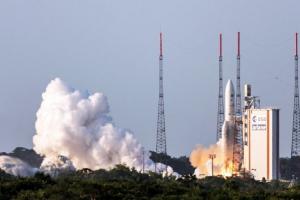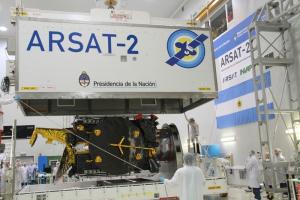On September 30, 2015 Argentine geostationary communications satellite ARSAT-2 was launched into space. ARSAT-2 is operated by the Argentine state company and was built by the Argentine company INVAP.
ARSAT-2 is the second satellite fully financed, developed and assembled in Argentina through the work of Argentine scientists. As a matter of fact, most of the satellite’s pieces have been manufactured in Argentina.
ARSAT-2 is the successor of ARSAT-1, the first Argentine satellite of this kind, which was launched on October 16, 2014. These two satellites have turned Argentina into one of the world’s eight countries that have the capacity to produce their own geostationary satellites.
Both satellites provide a broad range of telecommunications services, data transmission, internet access, telephone and television. However, unlike ARSAT-1, which only covers the territory of Argentina and neighbouring countries, ARSAT-2 reaches the entire American continent.
ARSAT-1 is also used for ATMs located in remote areas of Argentina, as well as in rural schools and other places that are not accessible via fibre optic.
The development of these satellites took five years and involved an investment of USD 280 million for ARSAT-1 and USD 250 million for ARSAT-2.
These satellites are expected to enhance the development of the Argentine industry of audiovisual contents generation, which now can be exported directly through Argentine satellites. Argentina currently produces around 60% of Spanish-speaking audiovisual content.

Background
In 2006 the Argentine government created ARSAT (Argentine Satellite Solutions Company) in order to keep hold of two orbital positions in the space that had been assigned to Argentina by the International Telecommunications Union.
The authorities believed that ARSAT should raise the country’s industrial base to the frontier of satellite technological development and thus decided that, rather than importing the satellites from the international market, ARSAT should obtain them from the Argentine companies.
The only alternative available was INVAP S.E, a technology company from Río Negro province dedicated to the construction of nuclear reactors that had been dabbling in the development of satellites.
In 2008 ARSAT hired INVAP to develop ARSAT-1, under the condition that the design rights would belong to ARSAT. In 2010 INVAP began to develop the satellite.
While INVAP took some parts such as propulsion engines or solar panels from foreign suppliers, over 50% of the parts were developed locally, as were the design, integration and testing.
This allows full control of the technology used for the satellite without the need for any foreign assistance, which is key from the point of view of the national security.



